Intel Z68 Chipset & Smart Response Technology (SSD Caching) Review
by Anand Lal Shimpi on May 11, 2011 2:34 AM ESTAnandTech Storage Bench 2011
With the hand timed real world tests out of the way, I wanted to do a better job of summarizing the performance benefit of Intel's SRT using our Storage Bench 2011 suite. Remember that the first time anything is ever encountered it won't be cached and even then, not all operations afterwards will be cached. Data can also be evicted out of the cache depending on other demands. As a result, overall performance looks more like a doubling of standalone HDD performance rather than the multi-x increase we see from moving entirely to an SSD.
Heavy 2011—Background
Last year we introduced our AnandTech Storage Bench, a suite of benchmarks that took traces of real OS/application usage and played them back in a repeatable manner. I assembled the traces myself out of frustration with the majority of what we have today in terms of SSD benchmarks.
Although the AnandTech Storage Bench tests did a good job of characterizing SSD performance, they weren't stressful enough. All of the tests performed less than 10GB of reads/writes and typically involved only 4GB of writes specifically. That's not even enough exceed the spare area on most SSDs. Most canned SSD benchmarks don't even come close to writing a single gigabyte of data, but that doesn't mean that simply writing 4GB is acceptable.
Originally I kept the benchmarks short enough that they wouldn't be a burden to run (~30 minutes) but long enough that they were representative of what a power user might do with their system.
Not too long ago I tweeted that I had created what I referred to as the Mother of All SSD Benchmarks (MOASB). Rather than only writing 4GB of data to the drive, this benchmark writes 106.32GB. It's the load you'd put on a drive after nearly two weeks of constant usage. And it takes a *long* time to run.
First, some details:
1) The MOASB, officially called AnandTech Storage Bench 2011—Heavy Workload, mainly focuses on the times when your I/O activity is the highest. There is a lot of downloading and application installing that happens during the course of this test. My thinking was that it's during application installs, file copies, downloading and multitasking with all of this that you can really notice performance differences between drives.
2) I tried to cover as many bases as possible with the software I incorporated into this test. There's a lot of photo editing in Photoshop, HTML editing in Dreamweaver, web browsing, game playing/level loading (Starcraft II & WoW are both a part of the test) as well as general use stuff (application installing, virus scanning). I included a large amount of email downloading, document creation and editing as well. To top it all off I even use Visual Studio 2008 to build Chromium during the test.
The test has 2,168,893 read operations and 1,783,447 write operations. The IO breakdown is as follows:
| AnandTech Storage Bench 2011—Heavy Workload IO Breakdown | ||||
| IO Size | % of Total | |||
| 4KB | 28% | |||
| 16KB | 10% | |||
| 32KB | 10% | |||
| 64KB | 4% | |||
Only 42% of all operations are sequential, the rest range from pseudo to fully random (with most falling in the pseudo-random category). Average queue depth is 4.625 IOs, with 59% of operations taking place in an IO queue of 1.
Many of you have asked for a better way to really characterize performance. Simply looking at IOPS doesn't really say much. As a result I'm going to be presenting Storage Bench 2011 data in a slightly different way. We'll have performance represented as Average MB/s, with higher numbers being better. At the same time I'll be reporting how long the SSD was busy while running this test. These disk busy graphs will show you exactly how much time was shaved off by using a faster drive vs. a slower one during the course of this test. Finally, I will also break out performance into reads, writes and combined. The reason I do this is to help balance out the fact that this test is unusually write intensive, which can often hide the benefits of a drive with good read performance.
There's also a new light workload for 2011. This is a far more reasonable, typical every day use case benchmark. Lots of web browsing, photo editing (but with a greater focus on photo consumption), video playback as well as some application installs and gaming. This test isn't nearly as write intensive as the MOASB but it's still multiple times more write intensive than what we were running last year.
As always I don't believe that these two benchmarks alone are enough to characterize the performance of a drive, but hopefully along with the rest of our tests they will help provide a better idea.
The testbed for Storage Bench 2011 has changed as well. We're now using a Sandy Bridge platform with full 6Gbps support for these tests. All of the older tests are still run on our X58 platform.
AnandTech Storage Bench 2011—Heavy Workload
We'll start out by looking at average data rate throughout our new heavy workload test:
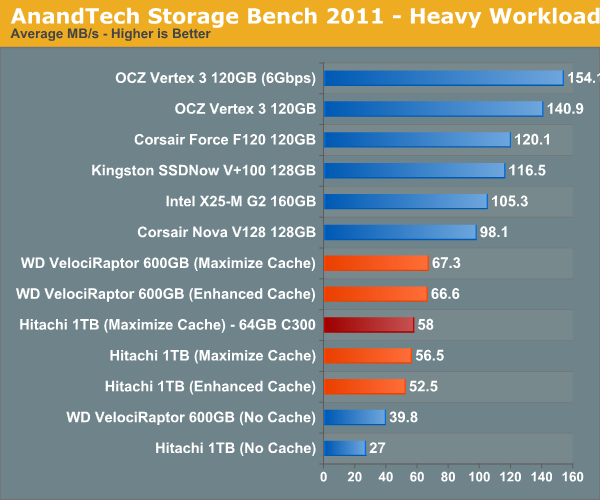
For this comparison I used two hard drives: 1) a Hitachi 7200RPM 1TB drive from 2008 and 2) a 600GB Western Digital VelociRaptor. The Hitachi 1TB is a good large, but aging drive, while the 600GB VR is a great example of a very high end spinning disk. With a modest 20GB cache enabled, the 3+ year old Hitachi drive is easily 41% faster than the VelociRaptor. We're still not into dedicated SSD territory, but the improvement is significant.
I also tried swapping the cache drive out with a Crucial RealSSD C300 (64GB). Performance went up a bit but not much. You'll notice that average read speed got the biggest boost from the C300 as a cache drive since it does have better sequential read performance. Overall I am impressed with Intel's SSD 311, I just wish the drive were a little bigger.
The breakdown of reads vs. writes tells us more of what's going on:
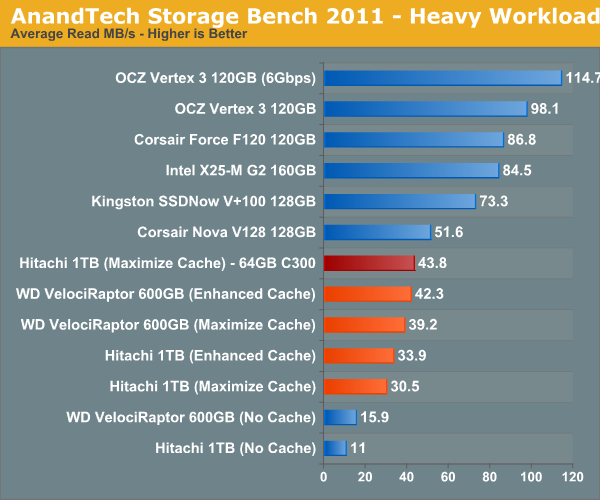
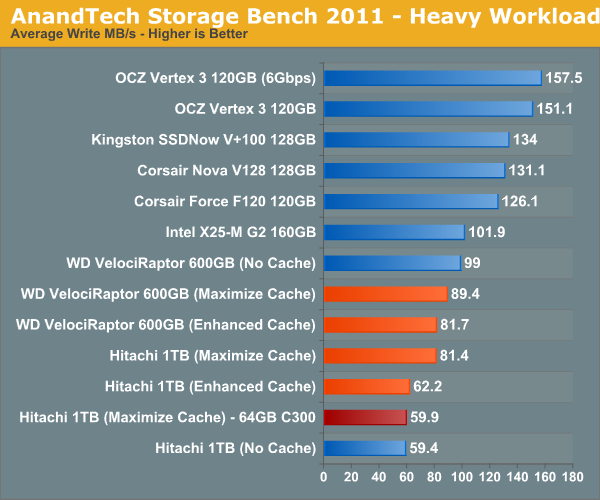
This isn't too unusual—pure write performance is actually better with the cache disabled than with it enabled. The SSD 311 has a good write speed for its capacity/channel configuration, but so does the VelociRaptor. Overall performance is still better with the cache enabled, but it's worth keeping in mind if you are using a particularly sluggish SSD with a hard drive that has very good sequential write performance.
The next three charts just represent the same data, but in a different manner. Instead of looking at average data rate, we're looking at how long the disk was busy for during this entire test. Note that disk busy time excludes any and all idles, this is just how long the SSD was busy doing something:
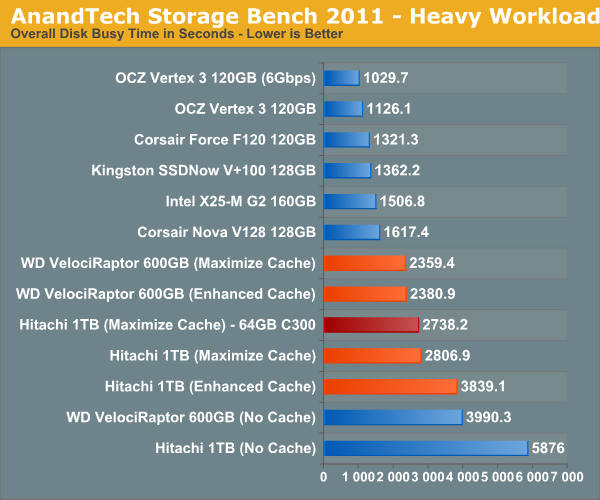
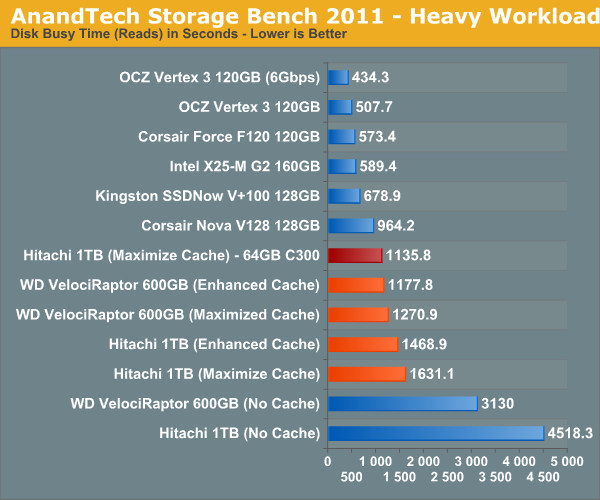











106 Comments
View All Comments
quang777 - Monday, August 8, 2011 - link
Does it work with older SSDs that don't support TRIM? Will SRT "cleanup" like TRIM to keep the cache "clean"?cbuck - Thursday, September 22, 2011 - link
For those working w/in the X58 chipset world and who have access to the Marvell 9128 "Hyperduo" SATA III (6GB) chip supported motherboards, what have people seen in terms of stability and speed?Understandably, the X58 chipset is a quickly fading market, but I happened to have a spare i7 920 D0 lying around and picked up a recently released LGA 1366 motherboard to put that CPU to use....
Tastare - Monday, October 31, 2011 - link
I'm looking for a functionality/application acting like:1. Smart responce technology (problem: cannot be used when OS is installed on SSD) or
2. Readyboost, but without deleting the cache during reboot.
I want a program/function working like a read and write cache(*) for a the 7200rpm drive (using e.g. 10-30GB of the SSD disk or USB for cache) that "survives" OS restart. Do anyone know if there exist any application with this functionality (Solutions I know: 1. buy a second SSD to use for HD cache, and 2. I could install OS on the 7200 rpm drive and use part of the SSD as cache)?
(*) With cache I mean something like:
- mirror the latest filecs read from the HD, and
- writes data directly to the USB, and later mirror the data to the Hard drive (when it has started up from idle to 7200rpm.)
Background: My system: Windows 7, Z68 motherboard, 120GB SSD + 1GB disk 7200rpm. The slower disk goes into standby (which is fine because I doesn't use it so often), but when data is needed it starts up slowly which is annoying.
bell2366 - Tuesday, February 28, 2012 - link
I'm suprised the HD manufacturers have not started fighting back and providing hybrid SSD/HDD's with write through cache etc, 1TB hard disk with 64GB SSD on board would rock.Especially if they take the supercapacitor route for guarenteed writes to SSD NAND on power failures.
I've recently bought one of the new Comay Venus 120GB SSD's and it has these features, not to mention performance that blows OCZ out of the water. Just wish I didn't have to mess around thinking what to keep on SSD and what to keep on HDD, a hybrid would be simplicity itself.
astrojny - Friday, May 4, 2012 - link
Any thought on using Intel's Smart Technology with the 1TB Western Digital Raptor that was just released?btkcsd - Saturday, December 13, 2014 - link
Do you know if SRT will work with all processors that are otherwise compatible with the Z68 chipset? I've seen some reports that only true "core" processors are supported, like the i3/i5/i7 while Sandy Bridge based Celerons and Pentiums are not.